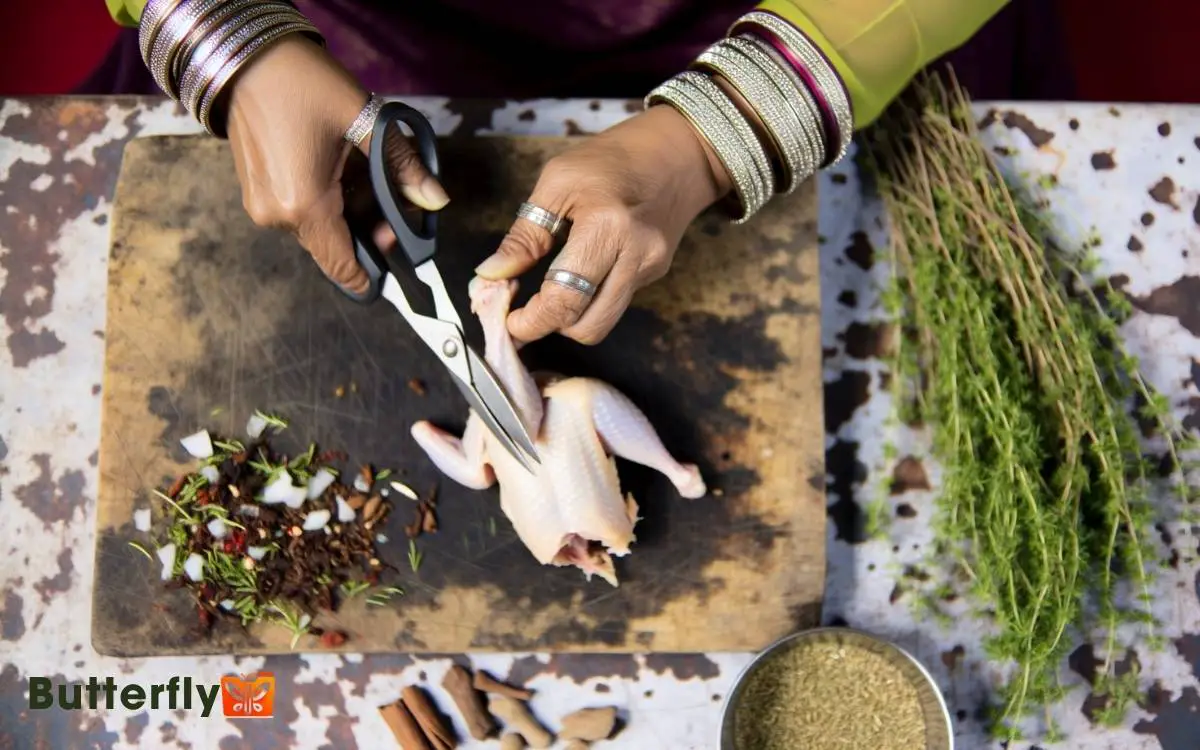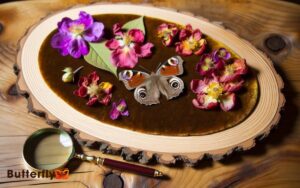How To Butterfly A Cornish Game Hen? Step-by-Step Guide!
To butterfly a Cornish game hen, start by positioning it breast-side down on a stable cutting board. Using sharp kitchen shears, cut along both sides of the backbone and remove it.
Flatten the hen by pressing down firmly on the breastbone until it lays flat. Preheat your oven to 425°F. Season the hen with your preferred spices and herbs, then roast it until a meat thermometer registers 165°F in the thickest part.
For extra crispy skin, broil it for a few minutes at the end. There’s even more to perfecting this technique for ideal results.

Key Takeaways
Gather Necessary Tools
To butterfly a Cornish game hen, you’ll need a sharp kitchen shear, a cutting board, and a pair of kitchen gloves.
Start by selecting shears that are robust and ergonomically designed for best control and precision.
Make sure your cutting board is stable and spacious enough to accommodate the hen without slipping; consider a non-slip mat underneath for added stability.
Kitchen gloves are essential to enhance grip and guarantee safety; opt for cut-resistant gloves for added protection.
By gathering these tools, you streamline the butterflying process and minimize risk. Each tool plays a critical role in enhancing your efficiency, precision, and safety.
Equip yourself properly, and you’re set to execute an innovative and professional culinary technique with finesse.
Select Fresh Hen
When selecting a fresh Cornish game hen, first check the expiry date to make sure it’s within a safe consumption range.
- Inspect the hen for any discoloration, unpleasant odor, or signs of freezer burn.
- Prioritize hens with clear, unblemished skin and a fresh, clean scent.
Check Expiry Date
Always check the expiry date on the packaging to make sure you’re selecting a fresh Cornish game hen. This step is essential to guarantee top-notch flavor and safety.
Locate the packaging date, typically labeled as ‘sell by‘ or ‘use by.’ Compare this date with today’s date to confirm the hen is within the recommended freshness period.
Don’t compromise; freshness directly affects the taste and tenderness of your dish. Avoid any packages with dates too close to or past the current date.
Your culinary creations deserve the best, and starting with a fresh hen is non-negotiable.
Inspect Hen Quality
After verifying the expiry date, examine the hen’s physical attributes to guarantee peak quality.
- First, check the color; a fresh hen should have a pale pink hue without any discoloration. The skin should appear smooth and moist, not slimy or sticky.
- Next, inspect the texture by pressing gently on the breast; it should feel firm and spring back quickly.
- Smell the hen; it should have a mild, clean scent, free from any sour or off-putting odors.
Additionally, confirm the packaging is intact, with no leaks or tears.
Prepare Your Workspace
Clear off your counter and gather all necessary tools to guarantee an efficient and hygienic preparation area. You’ll need a sharp chef’s knife, poultry shears, a cutting board, and a clean towel.
Position your cutting board on a non-slip surface to maintain stability. Sanitize your knife and shears beforehand to minimize contamination risks.
Use the clean towel to wipe tools and surfaces as required, ensuring cleanliness throughout the process. Keep a bowl nearby for discarding unwanted parts.
Organize your workspace to allow ease of movement and access to tools. Prioritize hygiene by frequently washing your hands and sanitizing surfaces. An orderly, sanitized workspace enhances efficiency and ensures the highest standards of food safety.
Position the Hen
Place the Cornish game hen breast-side down on the cutting board, ensuring its backbone is facing up. This orientation is essential for accurate and efficient processing. Use a firm, non-slip cutting board to stabilize the hen and prevent any movement.
Align the hen centrally on the board to maximize control and precision during the butchering process. Ensure the wings and legs are splayed out to the sides, providing a clear view of the backbone. This positioning will facilitate the subsequent steps and reduce the risk of errors.
Use a sharp pair of kitchen shears or a chef’s knife to make clean, precise cuts. Proper alignment and stability at this stage are key to achieving a professional butterfly cut. Maintain a steady grip on the meat to ensure even thickness throughout the cut. When you butterfly a flank steak, carefully slice horizontally while keeping the knife parallel to the cutting board. This technique allows for better stuffing, marinating, and even cooking.
Remove the Backbone
Using your sharp kitchen shears, cut along one side of the backbone from the tail to the neck. Maintain steady pressure to guarantee a clean cut, avoiding jagged edges.
Rotate the hen and repeat the process on the other side of the backbone, effectively detaching it. Discard the backbone or save it for making stock.
Next, inspect the hen for any remaining bone fragments or excess fat, removing these with precision. This meticulous preparation is vital for achieving an even cook and enhancing the bird’s flavor profile.
Flatten the Hen
After removing the backbone, place the hen breast side up on a cutting board.
- Press down firmly on the breastbone until the hen lies flat.
- Check for even thickness to make sure it cooks uniformly.
Remove Backbone Carefully
With a sharp pair of kitchen shears, carefully cut along one side of the backbone from the tail to the neck. Make sure your cuts are clean and controlled to maintain the integrity of the hen.
Repeat on the other side of the backbone, fully detaching it. Remove the backbone and set it aside for stock or discard it. This precise technique allows you to open the hen flat, optimizing it for even cooking.
Next, turn the hen over, breast side up. Align it on your cutting board, ensuring that the legs and wings are spread out uniformly. This alignment is essential for proper heat distribution.
Press Down Firmly
Firmly press down on the breastbone with both hands to flatten the hen completely. Make sure your hands are positioned evenly on either side of the breastbone.
Apply steady, consistent pressure until you hear a slight crack, indicating the breastbone has broken, allowing the hen to lie flat.
This step is essential for even cooking and ideal presentation. By flattening the hen, you enable uniform heat distribution, ensuring a perfectly roasted bird. Use a firm, controlled motion to avoid damaging the delicate meat. If necessary, use a meat mallet for additional force.
Check Even Thickness
Once the breastbone is broken, confirm that the hen’s thickness is uniform by pressing down on any uneven areas. This guarantees even cooking and ideal presentation. Focus on creating a consistent thickness by using firm, even pressure.
To achieve this:
- Use a meat mallet for stubborn areas.
- Adjust the position of the hen on the cutting board to gain better leverage.
- Check with your hands to feel for any remaining unevenness.
Maintaining uniform thickness is vital for innovative cooking techniques such as sous-vide or grilling. An even surface guarantees that the hen cooks uniformly, enhancing both texture and flavor. Precision at this step sets the foundation for a professional-grade dish.
Keep your focus on achieving a flat, even bird before proceeding.
Trim Excess Fat
Begin by identifying and removing any visible fat pockets around the cavity and under the skin of the Cornish game hen.
Use a sharp knife or kitchen shears for precise cutting. Trim the fat without removing too much skin, as the skin helps retain moisture and flavor during cooking.
Look for yellowish or whitish deposits, typically found near the tail or inside the cavity. Be meticulous to confirm no excess fat remains,
As it can lead to uneven cooking and unwanted greasiness. Focus on maintaining the hen’s structural integrity while enhancing its culinary potential.
This step is essential for achieving a lean, even texture and maximizing the crispiness of the skin during the roasting process.
Season the Hen
Sprinkle salt and pepper generously over every surface of the Cornish game hen to enhance its flavor. Confirm all nooks and crannies are well-seasoned, as this will guarantee a balanced taste profile.
Next, apply an innovative blend of spices to elevate the culinary experience. Consider the following options:
- Herbs de Provence: A fragrant mix of rosemary, thyme, and lavender.
- Smoked Paprika: Adds a subtle smokiness and rich color.
- Lemon Zest: Provides a bright, fresh contrast.
Massage these seasonings into the hen’s skin and cavity to ensure deep penetration and an even distribution.
Preheat the Oven
Preheat your oven to 425°F (220°C) to guarantee it reaches the ideal temperature for roasting the Cornish game hen efficiently. This temperature ensures best heat distribution, which is essential for achieving a crispy skin and juicy interior.
Use a reliable oven thermometer to confirm accuracy, as built-in oven gauges can be misleading. Set your oven rack in the middle position to allow for even air circulation. If your oven has a convection setting, activate it for enhanced airflow and consistent heat.
Don’t forget to remove any unnecessary racks that could obstruct airflow. By preheating properly, you’re setting the stage for successful roasting, ensuring your Cornish game hen will cook evenly and develop a beautifully browned exterior.
Cook the Hen
- Start by ensuring your oven is preheated to the specified temperature.
- Season the butterflied hen generously with your chosen spices and herbs.
- Place the hen on a baking sheet and monitor the cooking time closely to achieve best results.
Preheat the Oven
Set your oven to 375°F to guarantee the Cornish game hen cooks evenly and thoroughly. This temperature ensures that the meat remains juicy while achieving a crispy skin.
Preheating the oven is a critical step and shouldn’t be overlooked. It prepares the environment, allowing for consistent heat distribution.
While your oven preheats, you’ll want to:
- Confirm the oven rack is positioned in the center.
- Verify that your oven thermometer is accurate.
- Prepare a suitable baking dish or sheet pan.
These steps are essential for ideal cooking conditions.
Season the Hen
Rub the Cornish game hen generously with olive oil to guarantee the seasoning adheres well and the skin crisps up beautifully.
Combine sea salt, freshly ground black pepper, garlic powder, and smoked paprika in a small bowl. Sprinkle this mixture evenly over the entire hen, making sure there’s complete coverage for maximum flavor infusion.
For an innovative twist, consider adding finely chopped fresh herbs like rosemary and thyme, which will impart a fragrant aroma and complex taste profile.
Make sure the seasoning penetrates every crevice by gently massaging it into the meat. This meticulous attention to detail will elevate the flavor.
Place the seasoned hen on a rack in a roasting pan, breast side up, to ensure even heat distribution during cooking.
Monitor Cooking Time
Preheat your oven to 375°F (190°C) and place the seasoned Cornish game hen in the center rack to promote ideal air circulation and even cooking.
Monitor the cooking time closely to guarantee excellent results. Use a meat thermometer to check the internal temperature, which should reach 165°F (74°C) for safety.
- First 15 minutes: Bake at 375°F to sear the skin.
- Next 30-35 minutes: Reduce heat to 350°F (175°C) for thorough cooking.
- Final 5 minutes: Broil on high to achieve a crispy skin.
Check the hen periodically to prevent overcooking. Consistent monitoring and adjusting the oven settings will yield a perfectly cooked, butterfly Cornish game hen, combining innovation and precision in your culinary endeavors.
Check for Doneness
To check for doneness, insert an instant-read thermometer into the thickest part of the hen, making sure it reaches an internal temperature of 165°F. This step is essential to guarantee that the meat is safe to eat and cooked to its best.
Avoid piercing bone, as this can give an inaccurate reading. Confirm that the juices run clear with no traces of pink. If the temperature falls below 165°F, continue cooking in five-minute increments, checking each time.
For even more precision, consider using a dual-probe thermometer to monitor both the oven and meat temperatures simultaneously. This innovative approach ensures consistent results and enhances your cooking technique.
Serve and Enjoy
Once the Cornish game hen reaches the desired internal temperature and the juices run clear, transfer it to a serving platter to rest for a few minutes. Resting allows the juices to redistribute, ensuring a moist and flavorful result.
While the hen rests, prepare your serving accompaniments. To create an innovative dining experience, consider the following:
- Garnish: Fresh herbs such as rosemary or thyme add a burst of color and aroma.
- Sides: Complement with roasted vegetables, such as carrots and Brussels sprouts.
- Sauce: A reduction sauce using the hen’s drippings enhances the flavor profile.
When ready, carve the hen into portions, ensuring each piece retains its juiciness. Serve immediately while hot to fully enjoy the expertly prepared dish.
Conclusion
Once you’ve mastered butterflying a Cornish game hen, you’ll enjoy evenly cooked, juicy meat every time. Did you know that butterflying can reduce cooking time by up to 25%? This method guarantees a quicker, more efficient cooking process without sacrificing flavor.
By following these steps, you’ve not only enhanced your culinary skills but also improved your kitchen efficiency. Now, serve your perfectly cooked hen and savor the results of your precise preparation.






